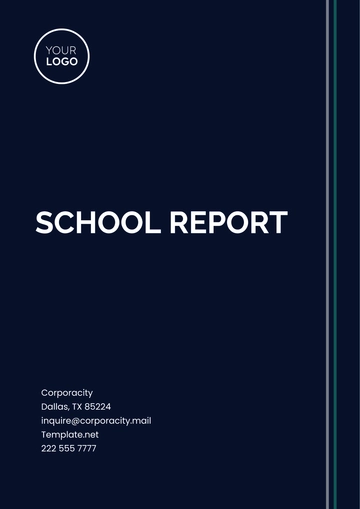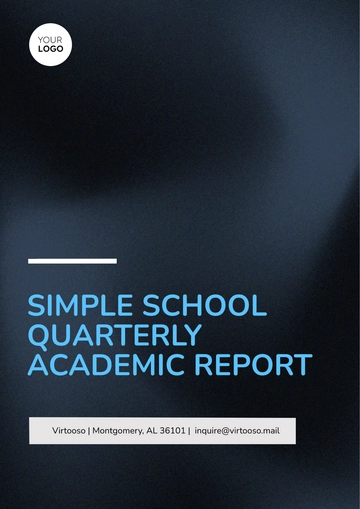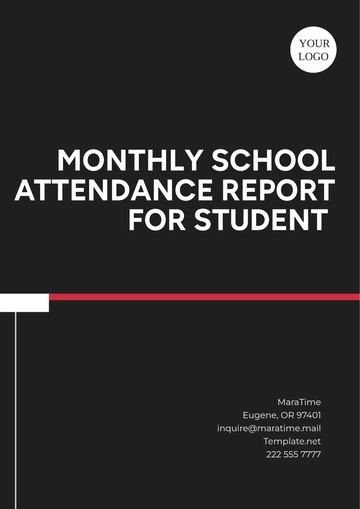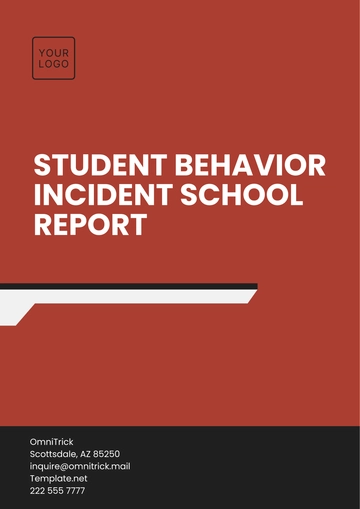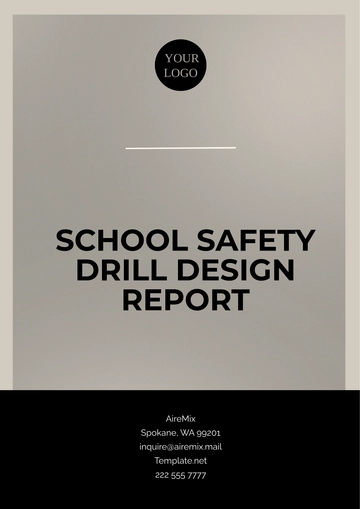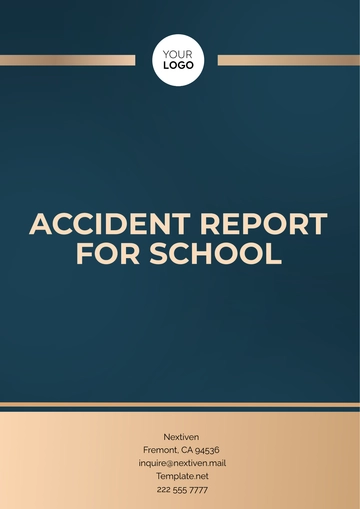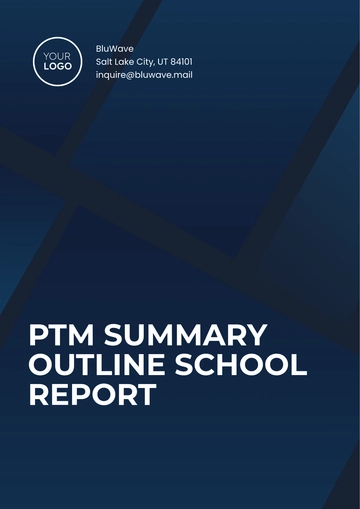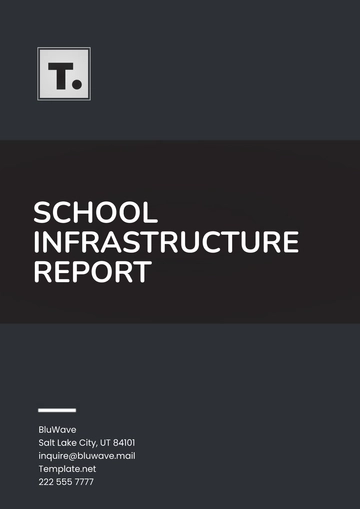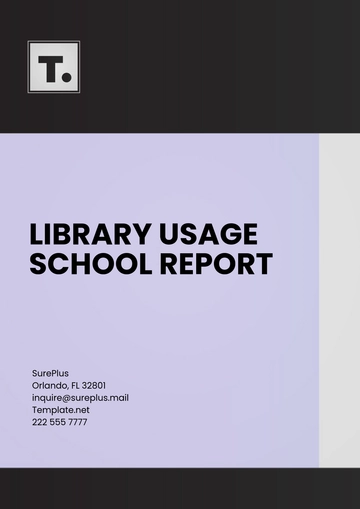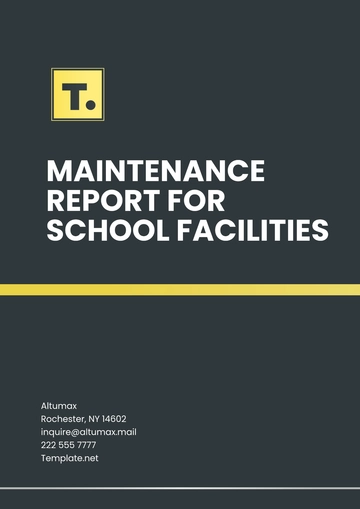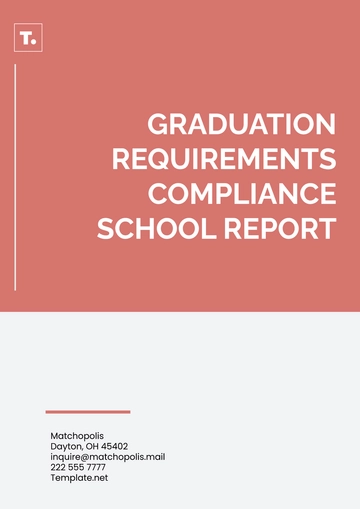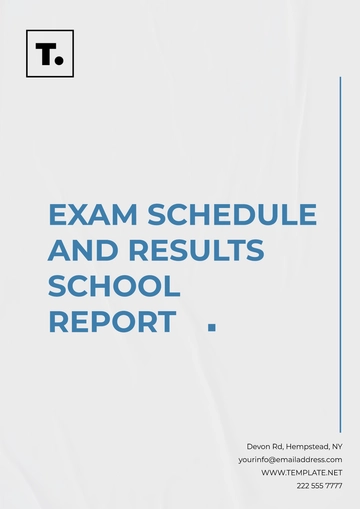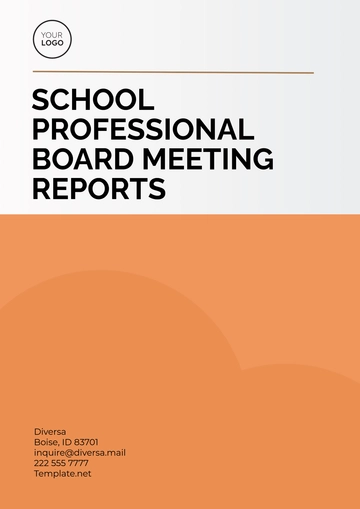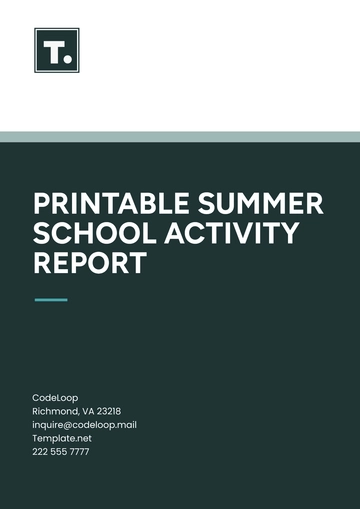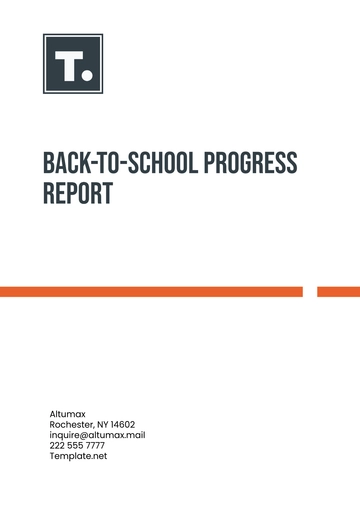Free School Health Report
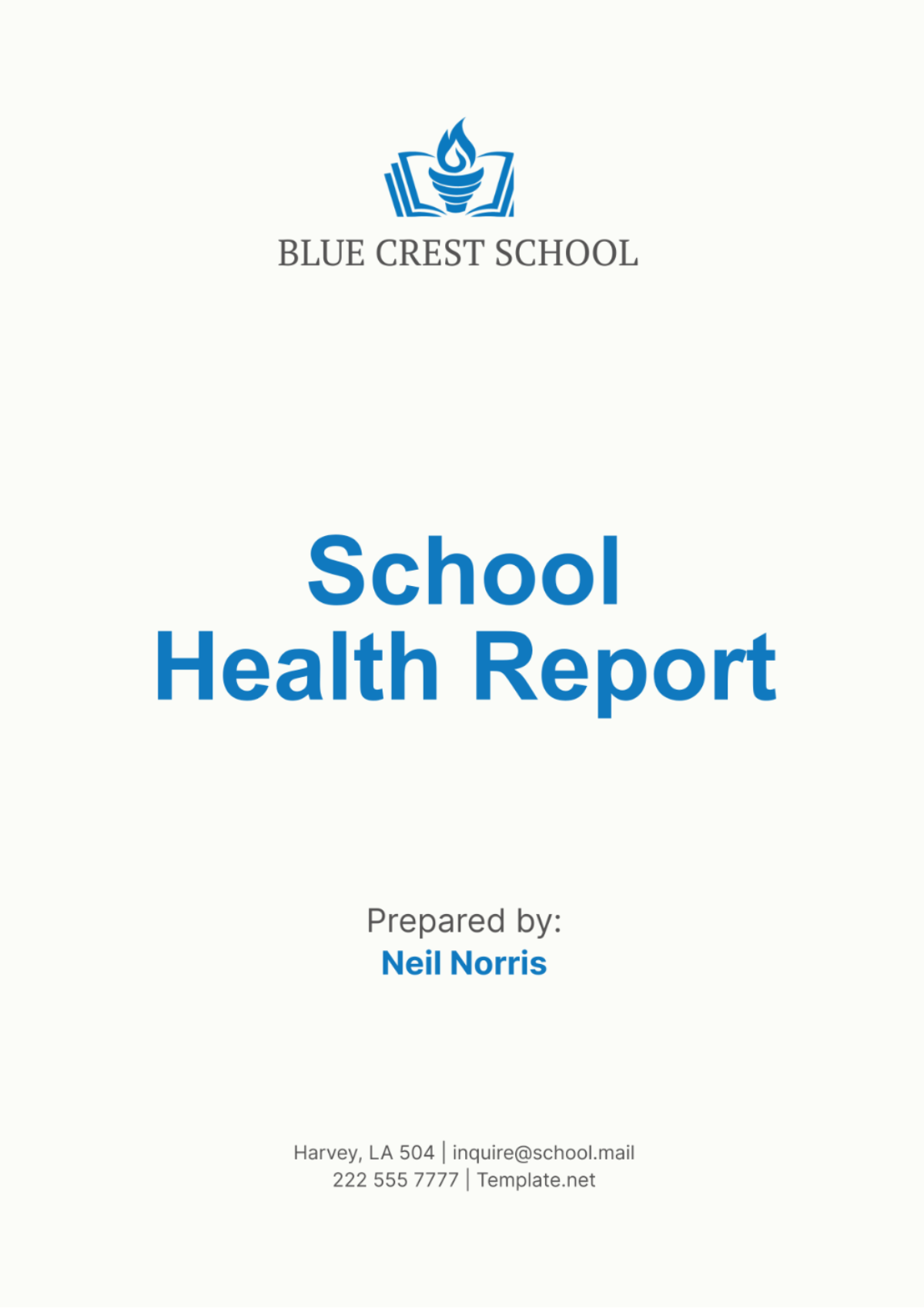
I. Executive Summary
A. Purpose of the Report
The purpose of this report is to provide a comprehensive overview of the health status, services, and programs at [Your Company Name]. It aims to identify key health issues among students, assess the effectiveness of current health initiatives, and recommend future actions to enhance student well-being. This report serves as a tool for school administrators, healthcare providers, and policymakers to make informed decisions. Ultimately, it seeks to improve the overall health environment within the school.
B. Key Findings
The report reveals a high compliance rate with immunization requirements, standing at 95%, ensuring protection against common preventable diseases. There is an increasing prevalence of asthma among students, currently affecting 12% of the student population. Participation in physical education is robust, with 85% of students actively engaging in physical activities. Additionally, there have been notable improvements in dental health following the introduction of a school-based dental program, reducing untreated dental issues by 15%.
C. Recommendations
To address the increasing demand for mental health services, it is recommended to expand the availability of school counselors and mental health programs. Implementing a targeted asthma management program can help reduce the number of asthma-related incidents and improve student quality of life. Enhancing nutrition education within the school curriculum will further support healthy eating habits among students. Regular monitoring and evaluation of these initiatives will be essential to ensure their effectiveness and sustainability.
II. Introduction
A. Overview of the School
School Demographics
[Your Company Name] serves a diverse population of 500 students from kindergarten through fifth grade.
Approximately 40% of the student body is eligible for free or reduced lunch, highlighting the socioeconomic diversity within the school.
The student population includes a mix of ethnic backgrounds, contributing to a rich cultural environment.
The school is situated in a suburban area, with strong community involvement and support.
Mission and Vision
The mission of [Your Company Name] is to provide a safe, nurturing environment that promotes academic excellence and health.
The school envisions every student achieving their highest potential in both academic and health outcomes, preparing them for future success.
A key component of this vision is fostering a holistic approach to education, integrating physical, mental, and emotional well-being.
The school is committed to continuous improvement and innovation in its health and wellness programs.
B. Importance of School Health
A healthy school environment is crucial for academic success and overall student development. By addressing physical, mental, and social health needs, schools create a foundation for lifelong well-being and learning. Healthy students are more likely to attend school regularly, participate actively, and perform better academically. Investing in school health programs not only benefits individual students but also contributes to the well-being of the entire community.
C. Objectives of the Health Report
The primary objective of this health report is to evaluate the current health status of students at [Your Company Name]. It aims to assess the effectiveness of existing health programs and identify areas for improvement. The report provides actionable insights and recommendations to enhance health services and programs. Additionally, it serves as a resource for stakeholders to make data-driven decisions and allocate resources effectively.
III. Health Screenings and Assessments
A. Vision Screening
Methodology
Vision screenings are conducted annually using standardized eye charts and modern vision testing equipment.
Trained health professionals administer the screenings to ensure accuracy and reliability.
The screening process includes initial tests and follow-up evaluations for students who fail the preliminary tests.
Data is recorded systematically to track trends and identify students needing further eye care.
Results
In the most recent screening, 95% of the student population participated.
Out of those screened, 10% were identified as needing further evaluation for potential vision problems.
Common issues detected included nearsightedness, farsightedness, and astigmatism.
Follow-up evaluations confirmed that many of these students required corrective lenses.
Follow-up Actions
Parents of students identified with vision issues are notified promptly and provided with referral resources for eye care professionals.
The school collaborates with local optometrists to offer discounted or free eye exams and glasses for students in need.
Follow-up screenings are scheduled to monitor students' progress and ensure they receive necessary care.
Educational sessions on eye health and the importance of regular vision check-ups are conducted for students and parents.
B. Hearing Screening
Methodology
Annual hearing screenings are conducted using audiometers, with trained personnel overseeing the process.
Each student undergoes a series of tests to assess hearing acuity and detect potential hearing impairments.
The screenings are designed to identify both minor and significant hearing issues that may affect learning.
Detailed records are kept for each student to facilitate follow-up and long-term monitoring.
Results
In the latest round of screenings, 98% of students were tested for hearing acuity.
Approximately 5% of those tested were referred for additional testing due to suspected hearing issues.
Common findings included mild to moderate hearing loss, which can impact classroom performance.
Early detection through these screenings has led to timely interventions and support.
Follow-up Actions
Parents of students with suspected hearing issues are informed and provided with referrals to audiologists for comprehensive evaluations.
The school works with local healthcare providers to ensure students receive appropriate follow-up care and treatment.
Hearing aids and other assistive devices are made available to students as needed, often through community partnerships.
Ongoing support is provided to students with hearing impairments, including classroom accommodations and specialized instruction.
C. Dental Screening
Methodology
Dental screenings are conducted annually by visiting dental professionals who perform basic oral health assessments.
Screenings include visual examinations and discussions on oral hygiene practices with students.
The program aims to identify common dental issues such as cavities, gum disease, and orthodontic needs.
Educational materials on proper dental care are distributed to students and parents.
Results
In the most recent dental screenings, 90% of students were examined by dental professionals.
Approximately 20% of those screened were found to have dental issues requiring further attention.
Common problems identified included cavities, plaque buildup, and early signs of gum disease.
The screenings also highlighted a need for increased dental health education among students.
Follow-up Actions
Students with identified dental issues are referred to local dental clinics for comprehensive treatment.
The school partners with dental health organizations to provide free or low-cost dental care to underserved students.
Follow-up programs include in-school dental check-ups and preventive care workshops.
Regular monitoring ensures that students receive ongoing dental care and maintain good oral hygiene practices.
D. General Health Assessments
Methodology
General health assessments include regular checks of BMI, blood pressure, and overall physical health conducted by the school nurse.
These assessments are performed annually and recorded in each student's health file.
The assessments aim to identify students at risk of health issues such as obesity, hypertension, and developmental delays.
Collaboration with local healthcare providers ensures comprehensive follow-up care for identified issues.
Results
In the latest assessments, 85% of students were found to be within a healthy BMI range.
Approximately 10% of students were identified as overweight or obese, highlighting the need for targeted interventions.
5% of students were found to have elevated blood pressure, necessitating further medical evaluation.
Overall, the assessments provided valuable data on the general health status of the student population.
Follow-up Actions
Students identified with health issues receive personalized care plans developed in collaboration with their parents and healthcare providers.
Nutritional counseling and physical activity programs are implemented to address issues such as obesity and hypertension.
Regular follow-up assessments are scheduled to monitor progress and adjust care plans as needed.
Health education sessions for students and parents are conducted to promote healthy lifestyle choices.
IV. Immunization Records
A. Immunization Requirements
[Your Company Name] adheres to state-mandated vaccination requirements, including vaccines for MMR, DTaP, Varicella, and others.
These requirements are communicated to parents upon enrollment and throughout the school year.
The school maintains detailed immunization records for each student, ensuring compliance with health regulations.
Regular updates and reminders are sent to parents about upcoming vaccination deadlines and clinics.
B. Immunization Compliance Rates
The current immunization compliance rate at [Your Company Name] stands at 95%, with efforts ongoing to reach full compliance.
Regular audits of immunization records help identify students who are not up-to-date on their vaccines.
The school has seen a steady increase in compliance rates due to proactive communication and support for parents.
Non-compliant students are followed up with individually to address barriers to vaccination.
C. Strategies to Improve Immunization Rates
Educational campaigns are conducted to inform parents about the importance and benefits of vaccinations.
The school collaborates with local health departments to host on-site vaccination clinics, making it easier for families to access vaccines.
Incentives such as certificates and recognition programs are implemented to encourage timely vaccinations.
Continuous engagement with parents, including one-on-one meetings and informational sessions, helps address concerns and misconceptions about vaccines.
V. Chronic Disease Management
A. Prevalence of Chronic Conditions
Asthma
Asthma is currently the most common chronic condition, affecting 12% of students at [Your Company Name].
Many students experience asthma symptoms triggered by allergens and physical activity.
The school has implemented an asthma action plan to help manage and reduce asthma-related incidents.
Regular training for staff on asthma management ensures a supportive environment for affected students.
Diabetes
Type 1 diabetes affects 2% of students, requiring daily management and monitoring.
The school nurse works closely with these students to monitor blood sugar levels and administer insulin as needed.
Educational sessions on diabetes management are provided for staff and students to increase awareness and support.
Collaboration with parents and healthcare providers ensures comprehensive care for students with diabetes.
Allergies
Various allergies, including food allergies and environmental allergies, affect 15% of the student population.
The school has strict protocols in place to manage and prevent allergic reactions, including allergen-free zones and emergency action plans.
Staff are trained to recognize and respond to allergic reactions promptly, ensuring student safety.
Regular communication with parents helps keep allergy management plans up-to-date and effective.
B. Support Systems and Programs
The asthma management program includes personalized action plans, regular check-ups, and medication administration.
Diabetes care plans involve detailed monitoring, nutritional guidance, and coordination with healthcare providers.
Allergy management includes staff training, emergency protocols, and creating safe environments for affected students.
Support groups and educational workshops are offered to students and parents, fostering a collaborative approach to chronic disease management.
C. Case Studies and Success Stories
A student with severe asthma who participated in the school's asthma program has seen a significant reduction in asthma attacks, allowing for better school attendance and participation.
Another student with Type 1 diabetes successfully managed their condition with the support of the school nurse, achieving better control over blood sugar levels and improved academic performance.
A group of students with severe food allergies has benefited from the school's allergen-free lunch program, experiencing fewer allergic reactions and feeling safer at school.
These success stories highlight the positive impact of comprehensive health programs and the importance of continued support and resources.
VI. Health Services Utilization
A. Visits to School Nurse
The school nurse sees an average of 15 visits per day, addressing a range of health issues from minor injuries to chronic disease management.
Common reasons for visits include headaches, stomachaches, minor cuts and bruises, and asthma attacks.
The nurse also provides medication administration, health counseling, and first aid.
Regular visits help in early detection of potential health problems, ensuring timely intervention and support.
B. Counseling and Mental Health Services
Approximately 10% of students received counseling services in the past year, addressing issues such as anxiety, depression, and behavioral challenges.
The school offers both individual and group counseling sessions, tailored to meet the diverse needs of students.
Mental health professionals collaborate with teachers and parents to provide comprehensive support and create a nurturing school environment.
Programs such as peer support groups and mindfulness workshops help students develop coping skills and resilience.
C. Referrals to External Health Services
About 5% of students were referred to external health providers for specialized care, including audiologists, optometrists, and mental health professionals.
Referrals are made based on initial screenings and assessments conducted at school.
The school maintains partnerships with local healthcare providers to facilitate seamless access to additional services.
Follow-up communication ensures that referred students receive the necessary care and support.
VII. Mental Health and Well-being
A. Mental Health Statistics
Recent data shows an increase in anxiety and depression cases among students, with 8% of the population affected.
The rise in mental health issues highlights the need for enhanced support and early intervention strategies.
Common stressors identified include academic pressure, social challenges, and family issues.
Addressing mental health proactively is crucial for fostering a positive and supportive school environment.
B. Counseling Services Provided
The school provides weekly individual counseling sessions for students needing one-on-one support.
Group counseling sessions focus on specific issues such as grief, bullying, and social skills development.
School counselors also offer workshops on stress management, resilience, and emotional regulation.
Collaboration with teachers helps integrate mental health support into daily classroom activities.
C. Mental Health Initiatives and Programs
The school has introduced mindfulness and stress reduction workshops to help students manage anxiety.
Anti-bullying campaigns promote a safe and inclusive school culture, reducing instances of bullying and peer conflict.
Partnerships with local mental health organizations provide additional resources and support for students and families.
Regular mental health screenings help identify at-risk students and ensure they receive timely interventions.
VIII. Nutrition and Physical Activity
A. Overview of School Meal Programs
Nutritional Standards
The school adheres to USDA nutritional guidelines, ensuring balanced and healthy meals for students.
Meals include a variety of fruits, vegetables, whole grains, and lean proteins.
Special dietary needs and allergies are accommodated to ensure all students have access to nutritious meals.
Ongoing evaluations ensure that the meal program meets the evolving nutritional needs of students.
Student Participation Rates
Approximately 70% of students participate in the school lunch program, with many also utilizing the breakfast program.
Efforts to increase participation include menu improvements, student feedback, and promotional activities.
The school has seen a gradual increase in participation rates due to these initiatives.
Healthy eating habits promoted through the meal program contribute to overall student well-being.
B. Physical Education Curriculum
Program Structure
The physical education curriculum includes a diverse range of activities, from traditional sports to fitness exercises and dance.
Classes are held twice a week, emphasizing physical fitness, teamwork, and healthy lifestyles.
The curriculum is designed to be inclusive, accommodating students of all abilities and fitness levels.
Regular assessments help track student progress and adjust the program to meet their needs.
Student Fitness Levels
85% of students meet age-appropriate fitness standards, reflecting the effectiveness of the PE program.
Fitness assessments are conducted biannually, measuring aspects such as endurance, strength, and flexibility.
Students are encouraged to set personal fitness goals and participate in extracurricular physical activities.
The school promotes a culture of physical activity, with events like fun runs and sports days.
C. Wellness Programs and Initiatives
After-School Programs
The school offers a variety of after-school programs, including sports clubs, yoga, and dance classes.
These programs provide additional opportunities for physical activity and skill development.
Participation in after-school programs is high, with many students benefiting from the structured activities.
The programs also foster social connections and a sense of community among students.
Community Partnerships
The school collaborates with local gyms, health organizations, and sports teams to enhance its wellness programs.
These partnerships provide access to additional resources, expertise, and facilities.
Community events and workshops promote healthy lifestyles and engage families in wellness activities.
Partnerships also support initiatives such as health fairs, fitness challenges, and nutrition education.
IX. Injury and Illness Data
A. Incidents of Injuries
Common injuries include playground accidents, sports-related injuries, and minor cuts and bruises.
The school has implemented safety protocols and supervision strategies to reduce the incidence of injuries.
Regular safety drills and first aid training for staff ensure a prompt and effective response to injuries.
Ongoing safety education for students helps promote awareness and prevent accidents.
B. Communicable Disease Incidences
The school monitors and manages outbreaks of communicable diseases, with a focus on prevention and early detection.
Recent incidences have included flu outbreaks, with vaccination campaigns in place to mitigate spread.
The school maintains strict hygiene and sanitation protocols to reduce the risk of disease transmission.
Health education sessions emphasize the importance of hygiene practices such as handwashing and covering coughs.
C. Health and Safety Protocols
Regular safety drills, including fire drills and lockdown drills, ensure preparedness for emergencies.
First aid training for staff includes CPR and the use of emergency medical equipment.
Health and safety protocols are reviewed and updated regularly to address emerging risks and best practices.
Collaboration with local emergency services ensures a coordinated response to potential incidents.
X. Health Education Programs
A. Curriculum Overview
Health education is integrated into the standard curriculum across all grade levels, covering topics such as nutrition, hygiene, and mental health.
The curriculum is designed to be age-appropriate and engaging, with a mix of lectures, activities, and discussions.
Guest speakers, including healthcare professionals and community health educators, enhance the learning experience.
Health education aims to empower students with the knowledge and skills to make informed health choices.
B. Impact on Student Knowledge and Behavior
Increased awareness of health issues and positive behavioral changes have been observed among students.
Surveys indicate that students have a better understanding of nutrition, exercise, and mental health after participating in health education programs.
Behavioral changes include healthier eating habits, increased physical activity, and improved hygiene practices.
Ongoing assessments ensure that the curriculum remains relevant and impactful.
C. Future Plans for Health Education
Expansion of mental health education to address the growing need for emotional and psychological support.
Introduction of digital health literacy programs to teach students about safe and effective use of health information and technology.
Enhanced collaboration with local health organizations to provide more comprehensive health education resources.
Continuous evaluation and updating of the curriculum to incorporate new health trends and research findings.
XI. Compliance and Standards
A. Local, State, and Federal Regulations
[Your Company Name] adheres rigorously to local, state, and federal health regulations to ensure the safety and well-being of its students and staff. This includes compliance with sanitation standards, immunization requirements, and safety protocols. Regular audits and inspections are conducted to assess compliance and identify areas for improvement. The school maintains close communication with health authorities to stay updated on any changes in regulations and promptly implements necessary adjustments.
B. Compliance Status
Recent audits have confirmed [Your Company Name]'s high level of compliance with health and safety regulations. Issues identified in previous audits have been addressed through targeted action plans and staff training initiatives. Compliance status is regularly reviewed and reported to school administration and relevant stakeholders. Continuous monitoring ensures that all policies and procedures are followed consistently across campus facilities and activities.
C. Actions Taken to Ensure Compliance
To maintain compliance, the school conducts regular staff training sessions on health and safety protocols. These sessions cover topics such as emergency response procedures, sanitation practices, and student health management. Documentation of training sessions and policy updates is maintained to demonstrate ongoing compliance efforts. Additionally, the school collaborates with external health agencies and educational partners to exchange best practices and ensure alignment with industry standards.
XII. Recommendations and Action Plans
A. Identified Health Needs
Based on the findings of this report, key health needs include expanding mental health resources, enhancing chronic disease management programs, and promoting healthier nutrition options. These areas have been identified as priorities for improving overall student well-being and academic success. Addressing these needs will require collaborative efforts among school administration, healthcare providers, and community stakeholders.
B. Recommended Interventions and Programs
To meet identified health needs, [Your Company Name] plans to hire additional mental health counselors to provide more comprehensive support services. A multidisciplinary approach will be adopted to enhance chronic disease management, including personalized care plans and regular health screenings. Nutrition education initiatives will be expanded to promote healthier eating habits and reduce childhood obesity rates. These interventions aim to create a supportive environment where students can thrive academically and socially.
C. Implementation Plan
The implementation of recommended interventions will be phased over the next academic year to ensure systematic rollout and effectiveness. Each intervention will be carefully monitored and evaluated for its impact on student health outcomes. Resources and funding will be allocated strategically to support the implementation plan, with input from school stakeholders and community partners. Regular progress reports will be shared with the school board and parent-teacher association to maintain transparency and accountability.
D. Evaluation and Monitoring
Continuous evaluation and monitoring will be integral to assessing the success of implemented interventions. Metrics such as student health indicators, program participation rates, and academic performance will be tracked and analyzed. Feedback from students, parents, and staff will be solicited to gauge satisfaction and identify areas for improvement. Adjustments to interventions will be made based on evaluation findings to optimize outcomes and ensure alignment with the school's health and wellness goals.
- 100% Customizable, free editor
- Access 1 Million+ Templates, photo’s & graphics
- Download or share as a template
- Click and replace photos, graphics, text, backgrounds
- Resize, crop, AI write & more
- Access advanced editor
Discover the ultimate School Health Report Template at Template.net. This editable and customizable template is crafted for school nurses and administrators. Streamline your health assessments effortlessly with intuitive features and an AI Editor Tool. Ensure comprehensive reporting with ease, tailored to your school's unique needs. Revolutionize your health reporting today with Template.net's user-friendly solution.
You may also like
- Sales Report
- Daily Report
- Project Report
- Business Report
- Weekly Report
- Incident Report
- Annual Report
- Report Layout
- Report Design
- Progress Report
- Marketing Report
- Company Report
- Monthly Report
- Audit Report
- Status Report
- School Report
- Reports Hr
- Management Report
- Project Status Report
- Handover Report
- Health And Safety Report
- Restaurant Report
- Construction Report
- Research Report
- Evaluation Report
- Investigation Report
- Employee Report
- Advertising Report
- Weekly Status Report
- Project Management Report
- Finance Report
- Service Report
- Technical Report
- Meeting Report
- Quarterly Report
- Inspection Report
- Medical Report
- Test Report
- Summary Report
- Inventory Report
- Valuation Report
- Operations Report
- Payroll Report
- Training Report
- Job Report
- Case Report
- Performance Report
- Board Report
- Internal Audit Report
- Student Report
- Monthly Management Report
- Small Business Report
- Accident Report
- Call Center Report
- Activity Report
- IT and Software Report
- Internship Report
- Visit Report
- Product Report
- Book Report
- Property Report
- Recruitment Report
- University Report
- Event Report
- SEO Report
- Conference Report
- Narrative Report
- Nursing Home Report
- Preschool Report
- Call Report
- Customer Report
- Employee Incident Report
- Accomplishment Report
- Social Media Report
- Work From Home Report
- Security Report
- Damage Report
- Quality Report
- Internal Report
- Nurse Report
- Real Estate Report
- Hotel Report
- Equipment Report
- Credit Report
- Field Report
- Non Profit Report
- Maintenance Report
- News Report
- Survey Report
- Executive Report
- Law Firm Report
- Advertising Agency Report
- Interior Design Report
- Travel Agency Report
- Stock Report
- Salon Report
- Bug Report
- Workplace Report
- Action Report
- Investor Report
- Cleaning Services Report
- Consulting Report
- Freelancer Report
- Site Visit Report
- Trip Report
- Classroom Observation Report
- Vehicle Report
- Final Report
- Software Report
